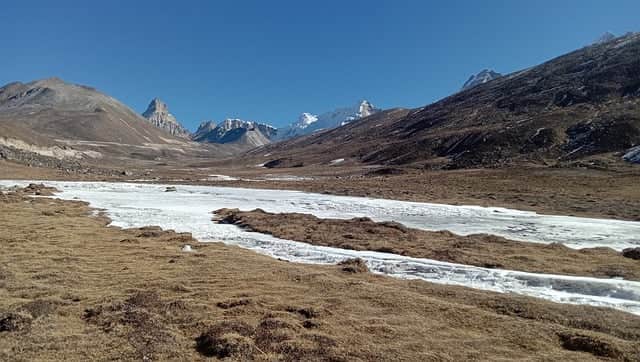Introduction – Sikkim

Nestled in the northeastern part of India, Sikkim is a mesmerizing land that beckons travelers with its unparalleled natural beauty and rich cultural heritage. From the towering peaks of the Himalayas to the vibrant festivals that light up its towns, This place is a destination that offers something for everyone. Known for its pristine landscapes, warm-hearted people, and spiritual serenity, Sikkim has become an essential part of India’s tourism map.
Geographical Marvel

Sikkim, the second smallest state in India, is located in the eastern Himalayas. Despite its small size, it boasts a diverse topography ranging from subtropical climates in the lower regions to alpine conditions in the higher altitudes. The state is bordered by Bhutan, Tibet, and Nepal, making it a cultural and geographical bridge between these regions. The best time to visit this place is during the spring (March to May) and autumn (September to November) when the weather is pleasant, and the natural beauty is at its peak.
History

Sikkim has a fascinating history that dates back to the 17th century when it was established as a Buddhist kingdom. The Namgyal dynasty ruled this place for over 300 years, and the state’s history is deeply intertwined with Buddhism. In 1975, Sikkim became the 22nd state of India after a historic referendum, marking the end of its monarchy and the beginning of its integration into the Indian Union.
Culture and Tradition

Sikkim’s cultural fabric is a rich tapestry woven from its ethnic diversity. The major communities here include the Lepchas, Bhutias, and Nepalis, each contributing to the state’s vibrant culture. Festivals like Losar, Bumchu, and Saga Dawa are celebrated with great enthusiasm, showcasing the state’s spiritual and cultural richness. Traditional attire, such as the Bhutia “Bakhu” and the Lepcha “Dumdyam,” reflects the unique identity of the people.
Language and Literature
Sikkim is a multilingual state where several languages are spoken. The official languages include Nepali, Sikkimese (Bhutia), and Lepcha, with English being widely used for administrative purposes. Sikkim’s literary scene is gradually growing, with contributions from local authors and poets who write in Nepali and other regional languages, enriching the state’s cultural heritage.
Biodiversity and Wildlife
Sikkim is a biodiversity hotspot, rich in diverse flora and fauna. The state’s rich ecosystem includes rare orchids, rhododendrons, and medicinal plants. National parks, such as the Khangchendzonga National Park, a UNESCO World Heritage Site, provide sanctuary to endangered species like the red panda, snow leopard, and Himalayan black bear. These protected areas offer nature lovers a glimpse into the state’s thriving wildlife.
Adventure Tourism

For adventure enthusiasts, Sikkim is nothing short of paradise. The state offers numerous trekking routes, including the famous Goechala trek, which provides breathtaking views of the mighty Kanchenjunga. River rafting in the Teesta and Rangit rivers, paragliding in Gangtok, and mountain biking in the rugged terrain are just a few of the adrenaline-pumping activities available here.
Spiritual
Sikkim is often referred to as a land of spirituality, and for a good reason. The state is dotted with ancient monasteries that are not only architectural marvels but also centers of spiritual practice. The Rumtek Monastery, Pemayangtse Monastery, and Tashiding Monastery are some of the most revered religious sites to visit. Buddhism plays a significant role in the lives of the Sikkimese people, and the state’s spiritual aura is palpable in its peaceful surroundings.
Cuisine
The cuisine of Sikkim is a delightful blend of flavors influenced by its diverse communities and neighboring regions. Traditional dishes like “Momos” (steamed dumplings), “Thukpa” (noodle soup), and “Phagshapa” (pork with radishes) are must-try delicacies. The use of fresh, local ingredients and the emphasis on simplicity make Sikkimese food both hearty and healthy.
Places to Visit

Gangtok: The Capital City
Gangtok, the capital of Sikkim, is a bustling town with a mix of modernity and tradition. It offers stunning views of the Himalayas, vibrant markets, and serene monasteries.
Tsomgo Lake and Nathula Pass
Located near the Indo-China border, Tsomgo Lake is a glacial lake that remains frozen during the winter months. Nathula Pass, once a part of the ancient Silk Route, is a historic pass that offers breathtaking views.
Pelling and its Majestic Views
Pelling is known for its panoramic views of the Kanchenjunga range. It is also home to the Pemayangtse Monastery and the Rabdentse ruins, which hold historical significance.
Yuksom: The Historical Town
Yuksom, the first capital of Sikkim, is a quaint town steeped in history. It serves as the starting point for several treks, including the famous Dzongri-Goechala trek.
Lachung and Lachen
North Sikkim, with its picturesque villages of Lachung and Lachen, is known for its pristine beauty. The Yumthang Valley, also known as the Valley of Flowers, and the Gurudongmar Lake are some of the region’s top attractions.

Sustainable Tourism
Sikkim has been a pioneer in promoting sustainable tourism practices. The state has banned plastic bags and non-biodegradable products, promoting eco-friendly alternatives. Commitment to organic farming has earned it the title of India’s first organic state, making it a model for sustainable development.
Transport and Accessibility
Sikkim is well-connected to the rest of India by road, air, and rail. The nearest airport is Bagdogra in West Bengal, from where one can take a helicopter service or drive to Sikkim. The New Jalpaiguri Railway Station is the closest railhead. Local transport options include taxis, buses, and bike rentals, making it easy for visitors to explore the state.
Accommodation
Sikkim offers a wide range of accommodation options, from luxury hotels to budget-friendly homestays. Gangtok, being the capital, has the most extensive selection of hotels, while towns like Pelling, Yuksom, and Lachung offer cozy homestays that provide an authentic Sikkimese experience.
Shopping
Sikkim is a shopper’s delight, with its markets offering a variety of traditional handicrafts, hand-woven carpets, and local artifacts. The Lal Bazaar in Gangtok is a popular spot for picking up souvenirs, while the Old Market in Pelling is known for its collection of Tibetan artifacts.
Conclusion
Sikkim is a land that captivates the heart and soul of every traveler. Its natural beauty, cultural richness, and spiritual serenity make it a unique destination in India. Whether you seek adventure, tranquility, or a cultural experience, This place offers it all in abundance. A visit to this enchanting state is not just a journey but an experience that stays with you long after you’ve left its serene landscapes.
Picture credits: https://www.pexels.com/ ; https://pixabay.com/
Like this post?
Give a glance to other posts from Indyviews : https://indyviews.in/blogsy/
